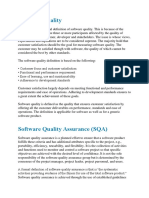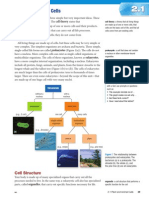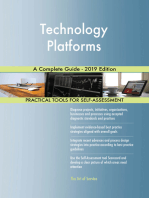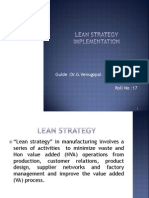Free ITIL Sample Paper 2
Free ITIL Sample Paper 2
Uploaded by
bruteforce198577Copyright:
Available Formats
Free ITIL Sample Paper 2
Free ITIL Sample Paper 2
Uploaded by
bruteforce198577Original Description:
Copyright
Available Formats
Share this document
Did you find this document useful?
Is this content inappropriate?
Copyright:
Available Formats
Free ITIL Sample Paper 2
Free ITIL Sample Paper 2
Uploaded by
bruteforce198577Copyright:
Available Formats
Free ITIL v.3.
Foundation
Exam Sample Paper 2
You have 1 hour to complete all 40 Questions You must get 26 or more correct to pass
Compliments of Advance ITSM www.advanceitsm.com
1. How can an organization determine the effectiveness of the Service Level Management process? a. By checking contracts with suppliers b. By measuring customer satisfaction c. By defining service levels d. By reporting on all incidents
2. Which of the following questions is NOT answered by Capacity Plan? a) b) c) d) Capacity Forecasts Recommendations Components and resource forecasts Countermeasures for risks
3. Which of the following best describes Fault Tolerance? a) The ability of an IT Service or Configuration Item to continue to operate correctly after Failure of a Component part. b) The ability of a third-party supplier to meet the terms of their contract. Often this contract will include agreed levels of availability, reliability and/or maintainability for a supporting service or component. c) A measure of how quickly and effectively a service, component or CI can be restored to normal working after a failure. d) A measure of how long a service, component or CI can perform its agreed function without interruption
4. Which statements below are correct about the Application Portfolio? 1. A database or structured Document used to manage Applications throughout their Lifecycle. 2. The Application Portfolio contains key Attributes of all Applications. 3. The Application Portfolio is sometimes implemented as part of the Service Portfolio, or as part of the Configuration Management System. A. 1 only B. 2 & 3only C. All of above D. 1 & 2 only
5. Which of the following should be documented in an Incident Model? 1. Details of the Service Level Agreement (SLA) pertaining to the incident 2. Chronological order of steps to resolve the incident
a) 1 only b) 2 only c) Both of the above d) Neither of the above
6. What does Mean Time to Repair (MTTR) mean?
a) Average uptime of a service b) Average downtime of a service c) Average time between two consecutive incidents d) Average time of the breakdown-free period within a measured period
7. Which of the following statements about Supplier and Contract Database (SCD) are correct? 1. A database or structured Document used to manage Supplier Contracts throughout their Lifecycle. 2. The SCD contains key Attributes of all Contracts with Suppliers 3. Its never part of the Service Knowledge Management System. 4. Maintaining it is responsibility of Supplier management process
a) b) c) d)
1 & 2 only 1, 2 & 3 1, 2 & 4 All of above
8. Which of the following best describes the goal of Information Security Management Process? a. To align IT security with business security and ensure that information security is effectively managed in all service and Service Management activities. b. To ensure that that the information security risks are appropriately managed and enterprise information resources are used responsibly. c. To provide a focus for all aspects of IT security and manage all IT security activities. d. To provide the strategic direction for security activities and ensures objectives are achieved
9. Which of the following steps from the continual improvement Model is missing? 1. What Is the vision? 2. Where are we now? 3. Where do we want to be? 4. How do we get there? 5. Did we get there? 6.?
a) What is the ROI b) How much did it cost. c) How do we keep the momentum going. d) What is the VOI?
10. Which ITIL process manager requires a report specifying the duration of an interruption of a Configuration Item? a) Availability Manager b) Incident Manager c) Problem Manager d) Service Level Manager
11. What are the two major processes in problem Management?
a) Technical and Service b) Proactive and Reactive c) Resource and Proactive d) Reactive and Technical
12. In IT Service Continuity Management various precautionary measures are taken, for example using an emergency power provision. Which of the following ITIL processes could also initiate this kind of measure? a. b. c. d. Availability Management Capacity management Change Management Incident Management
13. IT Service Continuity Strategy should be based on? 1. Design of the service metrics 2. Business Continuity Strategy 3. Business Impact Analysis 4. Risk Assessment
a) 1, 2 and 4 only
b) 1, 2 and 3 only
c) 2, 3 and 4 only
d) 1, 3 and 4 only
14. Changes are divided into categories. What criterion defines a category for a change? a) b) c) d) The The The The consequences of the change such as Minor, Major, significant, etc. speed with which the change is made sequence in which the change is made Request for Change number that the change is assigned
15. Where are activities documented with the aim of improving an IT service?
a) Service Catalogue (SC) b) Service Improvement Program (SIP) c) Service Level Agreement (SLA) d) Service Quality Plan (SQP)
16. Which of the following is the BEST description of a Service Catalogue?
a) The part of the Service Portfolio that is visible to customers
b) A list of all Service Level Agreements (SLAs)
C) A list of all business requirements that have not yet become services
d) A document used by Service Operations to identify activities that they must perform
17. Which form of outsourcing provides domain based business expertise?
a) Application Service Provision b) Business Process Outsourcing c) Knowledge Process Outsourcing d) Co-Sourcing
18. Information is regularly exchanged between Problem Management and Change Management. What information is this?
a) Known Errors from Problem Management, on the basis of which Change
Management can generate Requests for Change (RFCs)
b) RFCs resulting from Known Errors c) RFCs from the users that Problem Management passes on to Change
Management
d) RFCs from the Service Desk that Problem Management passes on to
Change Management
19. Which of the following statements is CORRECT?
a) The Configuration Management System (CMS) is part of the Known Error Data Base (KEDB) b) The Service Knowledge Management System (SKMS) is part of the CMS c) The KEDB and the CMS form part of the larger SKMS d) The CMS is part of the Configuration Management Data Base (CMDB)
20. Which of the following is the process rather than a department?
a) Application Management b) Operations Management c) Service Desk d) Availability Management
21. What is the name of one or more secured locations used to house validated copies of software? a) Secure Store b) Configuration Management System c) Definitive Media Library d)Configuration Management Database
22. Which of the following is NOT one of the major functions described within ITIL? a) Service Desk b) Technical Management c) IT Operations management d) Data Management
23. Incident Management includes any event which disrupts or could potentially disrupt a service. Some incidents will not be new and are in fact reoccurrences of previous incidents. In these cases, organisations tend to develop Incident Models to handle common incidents which reoccur. Choose the answer below which shows the initial Incident Management process in the correct order: 1. Incident Logging 2. Incident Prioritization 3. Incident Categorization 4. Incident Diagnosis 5. Incident Escalation
a) 13245 b) 14325 c) 12345 d) 13452
24. Which of the following best defines a mixture of IT services being delivered by staff Internally & Externally Sourced? a) b) c) d) Internal Sourcing External Sourcing Co-Sourcing Managed Services
25. Major Incidents require? a) b) c) d) Separate procedures Less urgency Longer timescales Less documentation
26. The accounts team have noted that every time they run a quarterly budget report for a number of customer accounts simultaneously this produces a number of errors that have to be manually corrected. The Development department have corrected these errors in a new version. Which process is responsible for ensuring this updated version is tested? a) Configuration Management b) Incident Management c) Problem Management d) Release and Deployment Management
27. Which of the following may be defined in a process? 1. Roles 2. Activities 3. Functions 4. Guidelines 5. Standards 6. Governance Framework
a) 1, 2, 3 and 5 only b) All of the above c) 1. 2, 5 and 6 only d) 1, 2, 4, and 5 only
28. The Design Manager is responsible for the overall coordination and deployment of quality solution designs for services and processes. Which of the following are NOT responsibilities included in this role? a) Produce and maintain all necessary Service Transition Packages b) Produce quality, secure and resilient designs for new or improved services, technology architecture, processes or measurement systems that meet all the agreed current and future IT requirements of the organization c) Take the overall Service Strategies and ensure they are reflected in the Service Design process and the service designs that are produced d). Measuring the effectiveness and efficiency of the Service Design and supporting processes
29. Of which ITIL process are Reliability, Serviceability and Maintainability components? a. IT Service Continuity Management b. Service Level Management c. Problem Management d. Availability Management
30. Who is responsible for ensuring fairness and transparency a) Governance b) Capacity c) Service Level Management d) Service Strategy Manager
31. Which of the following is a PRIMARY concern of IT Governance? a) Measuring and improving the efficiency and effectiveness of processes b) Ensuring that processes and procedures are correctly followed c) Reducing the total cost of providing services d) Ensuring that agreed Service Level Requirements are met
32. Which Functions are in IT Operations Management a) Network Management and Application Management b) Technical Management and Application Management c) Facilities Management and Technical Management d) IT Operations Control and Facilities Management
33. What is the difference between a process and a project? a. A process is continuous and has no end date, whereas a project has a finite lifespan. b. A project is continuous and has no end date, whereas a process has a finite lifespan. c. A process stops when the objective has been achieved, whereas a project does not stop when the objective is met. d. In a project the focus is not on the result, whereas with a process the result is important
34. What is the meaning of the term Serviceability?
a. The degree of availability of the IT services that can be offered b. The degree of support that the Service Desk provides to the customer c. The degree to which the provision of IT services can be supported by
maintenance contracts
d. The degree to which the services agreed in the Service Level Agreement
(SLA) are complied with
35. Which of the following is a Process Owner responsible for? a) Purchasing tools to support the process b) Ensuring that targets specified in a Service Level Agreement (SLA) are met c) Carrying out activities defined in the process d) Ensuring that the process is performed as documented
36. Which of the following statements is CORRECT? An Incident occurs when 1. A user is unable to access a service during service hours 2. An authorised IT staff member is unable to access a service during service hours 3. A network segment fails and the user is not aware of any disruption to service 4. A user contacts the Service Desk about slow performance of an application a) All of the above b) 1 and 4 only c) 2 and 3 only d) None of the above
37. What is the BEST definition of an Incident Model?
a) The template used to define the Incident logging form used to report Incidents b) A type of Incident involving a standard (or model) type of Configuration Item (CI) c) A set of pre-defined steps to be followed when dealing with a known type of Incident d) An Incident that is easy to solve
38. Which of the following should a Service Catalogue contain? a) The version information of all software b) The organisational structure of the company c) Asset information d) Details of all operational services
39. Which of the following should be considered when designing measurement systems, methods and metrics? 1) The services 2) The architectures 3) The configuration items 4) The processes
a) 1, 2 and 3 only b) 1, 3 and 4 only c) 2, 3 and 4 only d) All of the above
40. Which of the following is the CORRECT description of the Four Ps of Service Design? a) A four step process for the design of effective service management b) A definition of the people and products required for successful design c) A set of questions that should be asked when reviewing design specifications d) The four major areas that need to be considered in the design of effective Service Management
Answers for sample paper 1
1 2 3 4 5 6 7 8 9 10 11 12 13 14 15 16 17 18 19 20
B D A C B B C A C A B A C A B A C B C D
21 22 23 24 25 26 27 28 29 30 31 32 33 34 35 36 37 38 39 40
C D A C A D D A D A B D A C D A C D D D
You might also like
- ITIL V3 at HP A Case StudyDocument41 pagesITIL V3 at HP A Case Studyjorisduda100% (1)
- Software Prototyping: Vishnu Chaitanya Reddy Nara Vcnoo1@latech - EduDocument13 pagesSoftware Prototyping: Vishnu Chaitanya Reddy Nara Vcnoo1@latech - Edugowthamj5400No ratings yet
- Aspnet The Complete Reference by Matthew Macdonald Robert Standefer 0072195134 PDFDocument5 pagesAspnet The Complete Reference by Matthew Macdonald Robert Standefer 0072195134 PDFShubham DeshpandeNo ratings yet
- Outsourcing Security Case StudyDocument13 pagesOutsourcing Security Case StudyismakieNo ratings yet
- Session 13 Chapter 12 Chopra 5thedDocument34 pagesSession 13 Chapter 12 Chopra 5thedNIkhil100% (1)
- Keith M. Sturges Eds. Neoliberalizing Educational Reform America's Quest For Profitable Market-Colonies and The Undoing of Public GoodDocument350 pagesKeith M. Sturges Eds. Neoliberalizing Educational Reform America's Quest For Profitable Market-Colonies and The Undoing of Public GoodasdinfoNo ratings yet
- ITIL - Dumps - Sds - 2009-02-23Document24 pagesITIL - Dumps - Sds - 2009-02-23Saswati SenguptaNo ratings yet
- BMO - Case StudyDocument6 pagesBMO - Case StudyRover Atvist100% (1)
- Python VDocument34 pagesPython Vsandhya100% (1)
- CS404 Embedded Systems Module Wise QuestionsDocument5 pagesCS404 Embedded Systems Module Wise QuestionsApp4jjt ThomasNo ratings yet
- AnsDocument3 pagesAnssaichait100% (1)
- System DevelopmentDocument4 pagesSystem DevelopmentSayed HossainNo ratings yet
- Case Study Report of CMMI Implementation at Bank of MontrealDocument4 pagesCase Study Report of CMMI Implementation at Bank of MontrealNazeyra Jamal100% (1)
- Cse-IV-unix and Shell Programming (10cs44) - NotesDocument161 pagesCse-IV-unix and Shell Programming (10cs44) - NotesShaik AdiNo ratings yet
- L04-The Components of Software Quality Assurance SystemDocument47 pagesL04-The Components of Software Quality Assurance SystemLee StevenNo ratings yet
- File System Vs DBMSDocument6 pagesFile System Vs DBMSSahilNo ratings yet
- SPM 3-I Couse File FormatDocument18 pagesSPM 3-I Couse File Formatnvsrinivasan1991No ratings yet
- Software Engineering NotesDocument53 pagesSoftware Engineering NotesJuhiRaiNo ratings yet
- Think Python Chapter 1Document15 pagesThink Python Chapter 1Joe MeyerNo ratings yet
- Fingerprint Based Patient Information SystemDocument4 pagesFingerprint Based Patient Information SystemInternational Journal of Innovative Science and Research Technology100% (2)
- Unit 3, Part 2 - Software Quality AssuranceDocument19 pagesUnit 3, Part 2 - Software Quality Assurancesanjeewani wimalarathneNo ratings yet
- Least Slack Time (LST) Scheduling Is ADocument3 pagesLeast Slack Time (LST) Scheduling Is AsalagramNo ratings yet
- Unit 1 - OS - Introduction - Question BankDocument3 pagesUnit 1 - OS - Introduction - Question BankUrja DhabardeNo ratings yet
- PDC 1 - PD ComputingDocument12 pagesPDC 1 - PD ComputingmishaNo ratings yet
- Chapter 3 - Architectural Tactics and PatternsDocument120 pagesChapter 3 - Architectural Tactics and PatternsAmsalu TessemaNo ratings yet
- Plant and Animal CellsDocument4 pagesPlant and Animal Cellsapi-238421605No ratings yet
- Macro MicroDocument48 pagesMacro MicroRiajimin100% (1)
- Aspire Set of QuestionsDocument21 pagesAspire Set of QuestionsGORAKNo ratings yet
- Chapter 8 Pankaj JaloteDocument7 pagesChapter 8 Pankaj JaloteRakshat GuptaNo ratings yet
- Latest Trends in Serverless Computing: Bachelors of Technology inDocument7 pagesLatest Trends in Serverless Computing: Bachelors of Technology inRavi KumarNo ratings yet
- Software Quality MetricsDocument3 pagesSoftware Quality MetricsspongechieNo ratings yet
- CP7301-Software Process and Project Management PDFDocument16 pagesCP7301-Software Process and Project Management PDFmaniNo ratings yet
- STQA Imp QuesDocument3 pagesSTQA Imp QuesAnubhav SinghNo ratings yet
- Client Server Architecture 1229147658096208 1Document64 pagesClient Server Architecture 1229147658096208 1reenu_shuklaNo ratings yet
- Lab 1: Preprocessing Using PythonDocument5 pagesLab 1: Preprocessing Using PythonPF 21 Disha GidwaniNo ratings yet
- Software Project Management: Aamir Anwar Lecturer Computer Science SZABIST, IslamabadDocument25 pagesSoftware Project Management: Aamir Anwar Lecturer Computer Science SZABIST, IslamabadShams Illahi100% (1)
- Rajib Mall Lecture NotesDocument69 pagesRajib Mall Lecture NotesAnuj Nagpal0% (1)
- Ch-2 Requirement Engineering ProcessDocument64 pagesCh-2 Requirement Engineering ProcessMilkii BizuNo ratings yet
- 2 - Text OperationDocument45 pages2 - Text OperationKirubel WakjiraNo ratings yet
- Lecturenote - 1938410780chapter 9 - Emerging Trends in Software Engineering (Lecture 15)Document20 pagesLecturenote - 1938410780chapter 9 - Emerging Trends in Software Engineering (Lecture 15)Miretu JaletaNo ratings yet
- Overview of Software Engineering and The Software Development Process UpdatedDocument23 pagesOverview of Software Engineering and The Software Development Process UpdatedYash GavateNo ratings yet
- Unit-1 Chp-2 Project Evaluation and Programme ManagementDocument40 pagesUnit-1 Chp-2 Project Evaluation and Programme ManagementPrabhat Gupta100% (1)
- Data Mining - Bayesian ClassificationDocument6 pagesData Mining - Bayesian ClassificationRaj EndranNo ratings yet
- SOFTWARE QUALITY ENGINEERING) Part 3Document12 pagesSOFTWARE QUALITY ENGINEERING) Part 3ashwanimpec20No ratings yet
- 1 Module 1 Parallelism Fundamentals Motivation Key Concepts and Challenges Parallel ComputingDocument81 pages1 Module 1 Parallelism Fundamentals Motivation Key Concepts and Challenges Parallel ComputingSAMINA ATTARINo ratings yet
- Simulation and Modelling - Assignment TwoDocument2 pagesSimulation and Modelling - Assignment TwoKennedy KamauNo ratings yet
- ccs346 EdaDocument2 pagesccs346 Edakokila sadeesh1986No ratings yet
- Systems Planning and SelectionDocument11 pagesSystems Planning and SelectionNATI NT100% (1)
- Chapter 7 Software ReliabilityDocument126 pagesChapter 7 Software ReliabilityRAHUL TULSYAN100% (3)
- Software and Engineering (Questions and Answers-1)Document4 pagesSoftware and Engineering (Questions and Answers-1)dolon10100% (2)
- Two Marks Questions and Answers For Object Oriented ProgrammingDocument22 pagesTwo Marks Questions and Answers For Object Oriented ProgrammingRaja SekarenNo ratings yet
- Assignment 2Document1 pageAssignment 2Saloni Mahajan0% (3)
- Data Communication and Networking Slides Chap 1Document31 pagesData Communication and Networking Slides Chap 1Takarookie67% (3)
- CS6703-Grid and Cloud NotesDocument73 pagesCS6703-Grid and Cloud NotesJosiah devasam100% (1)
- Programming Techniques::: Control Flow & LoopsDocument20 pagesProgramming Techniques::: Control Flow & LoopsSharion GeorgeNo ratings yet
- System Implementation and MaintenanceDocument8 pagesSystem Implementation and MaintenanceAtul MahajanNo ratings yet
- Strategic Management Lecture 1Document84 pagesStrategic Management Lecture 1Atiya ArshadNo ratings yet
- APC Trainer On... Procurement and Tendering (T062)Document7 pagesAPC Trainer On... Procurement and Tendering (T062)rajkumar_chinniahNo ratings yet
- Global Social Compliance ProgrammeDocument31 pagesGlobal Social Compliance ProgrammebeeyesyemNo ratings yet
- Executive Scrum@Scale Essence CardsDocument3 pagesExecutive Scrum@Scale Essence CardsChrisNo ratings yet
- Lean Strategy Implementation MethodologyDocument48 pagesLean Strategy Implementation MethodologyesilvarNo ratings yet
- Dilivery Managment Call AgentDocument8 pagesDilivery Managment Call AgentRKT SOLUTION TP Help DeskNo ratings yet
- Local Governance Popoy Research/PHILSDocument14 pagesLocal Governance Popoy Research/PHILSfamigo451No ratings yet
- Porter Five Forces AnalysisDocument7 pagesPorter Five Forces Analysisranveer215No ratings yet
- Disaster Management Plan 2018Document255 pagesDisaster Management Plan 2018sifoisbspNo ratings yet
- Unit 2 CGDocument6 pagesUnit 2 CGRaja SahilNo ratings yet
- Constitutional Law ReviewDocument1,594 pagesConstitutional Law ReviewMark Pasco100% (1)
- Human Resource PlanningDocument14 pagesHuman Resource PlanningBirat Sharma100% (1)
- Project Charter: Student Engagement Tracking System (SETS)Document1 pageProject Charter: Student Engagement Tracking System (SETS)oninebuenrNo ratings yet
- Gardner 1988 - Who - Is - An - Entrepreneur - Is - The - Wrong - QuestionDocument22 pagesGardner 1988 - Who - Is - An - Entrepreneur - Is - The - Wrong - QuestionChristiane Drozdek100% (1)
- Hoshin - X Matrix PDFDocument48 pagesHoshin - X Matrix PDFKishore PatilNo ratings yet
- Activity Based CostingDocument17 pagesActivity Based CostingSumedh Kakde100% (1)
- Iraq and The Democratic PeaceDocument4 pagesIraq and The Democratic PeaceGeovani Hernandez MartinezNo ratings yet
- 30+ Types of Project RiskDocument1 page30+ Types of Project RiskSulemanNo ratings yet
- CH 5. Strat HRMDocument9 pagesCH 5. Strat HRMErica DizonNo ratings yet
- Dale Carnegie Change Management GuideDocument3 pagesDale Carnegie Change Management GuideLintang Citra ChristianiNo ratings yet
- Strategic ManagementDocument32 pagesStrategic ManagementMazloom Koshur100% (1)
- PLMDocument4 pagesPLMDanish BashaNo ratings yet
- Attrition S A Blessing For Ites CompaniesDocument3 pagesAttrition S A Blessing For Ites CompaniesSanthosh Praveen KumarNo ratings yet
- Manufacturing Performance by TPMDocument13 pagesManufacturing Performance by TPMLabiz Saroni ZidaNo ratings yet
- Pol. Sci. Ch-3 Electoral Politics WorksheetDocument3 pagesPol. Sci. Ch-3 Electoral Politics WorksheetSiddhant NarayanNo ratings yet
- Election Law Premid Part IDocument21 pagesElection Law Premid Part IBuddy Brylle YbanezNo ratings yet
- Governance, Business Ethics, Risk Management and Internal Control Quiz 2 Name: Singco, Carl Cesar A. Section: BSA 3ADocument3 pagesGovernance, Business Ethics, Risk Management and Internal Control Quiz 2 Name: Singco, Carl Cesar A. Section: BSA 3AcarlNo ratings yet
- Certified List of Candidates For Congressional and Local Positions For The May 13, 2013 2013 National, Local and Armm ElectionsDocument2 pagesCertified List of Candidates For Congressional and Local Positions For The May 13, 2013 2013 National, Local and Armm ElectionsSunStar Philippine NewsNo ratings yet

























































































